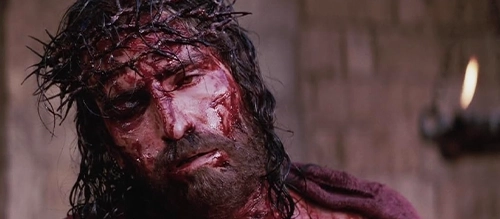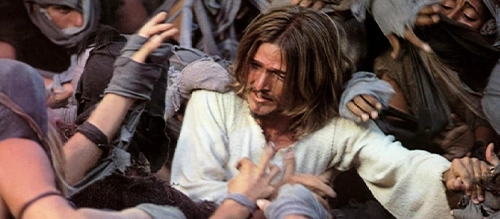5 Great Cinematic Depictions of Jesus Christ
The theory of there only being “Seven Stories” is a powerful one within art, with even the most contemporary publications having a basis in the ancient myths found at the dawn of human history. The story of Jesus Christ, the alleged Son of God, continues as one of the most compelling tales of all time. Elements of this archetypal tale of The Chosen One show up in all kinds of film franchises from Harry Potter to The Matrix. However, from the beginning of the establishment of cinema, there has been an ardent desire to portray the actual story of Christ, that of God becoming human so as to sacrifice himself for the sake of humanity.
Since the likes of The Life and Passion of Jesus Christ (1905) and From the Manger to the Cross (1912), countless actors have portrayed The Messiah. The role of Jesus Christ is to cinema what Hamlet is to theatre, a golden opportunity for an actor to prove his prowess. For some, fate and talent are on their side; but when it comes to Jesus Christ, a great performance doesn’t just become a well-loved role, it evolves into something else entirely.
For those who label Catholics as idolaters for their devotion towards sacred images, hypocrisy must be acknowledged as we are all in fact guilty when it comes to the film stars who have played Christ. Robert Powell from ‘Jesus of Nazareth’ (1977) has had to deal with the use of his promotional photos used as icons in Churches in places as far-flung as Venezuela. A popular meme is that of the image of Ewan McGregor in the part of Obi Wan Kenobi from the Star Wars franchise being often mistaken for Jesus and hence being hung up around houses by unwitting grandmothers. In terms of an actor’s performance, the term “iconic” becomes literal – do a good job and not only have you played a once in a lifetime role, but your face has become synonymous with Christ himself.
For those of the Christian faith, this is an obvious testament to their greatest wish to look into the eyes of The Saviour – an actor who brings in a heartfelt and believable performance is, in effect, a proxy. But what is it that makes a depiction of Christ truly great? Is it faithfulness to gospel canon like Pier Paolo Pasolini’s The Gospel According to St Matthew (1967)? Is it the use of artistic expression to tell Christ’s story like in Jesus Christ Superstar (1973)? Or is it a thorough exploration of Christ’s mysterious character like in Martin Scorsese’s The Last Temptation of Christ (1988)? In this Movie List from The Film Magazine, this answer is explored through 5 truly great cinematic depictions of Christ.
(To be considered a candidate for this list, there was the requirement to have a cinematic release. Therefore, the likes of TV movies and miniseries – including the beloved ‘Jesus of Nazareth’ – are sadly excluded.)
1. The Passion of the Christ (2004) Jim Caviezel

The Passion of the Christ is a cultural phenomenon – a film personally financed by its director after it failed to get any major studio backing and then became one of the most profitable R-Rated movies of all time. That in itself is an amazing story.
Much of this phenomena can be attributed to the lead performance of Jim Caviezel. Despite this film’s many controversies, Caviezel’s performance at the centre of it has brought many a hardened soul to tears. Even with many handicaps to his performance, including heavy prosthetics and speaking a dead language, Caviezel’s bloodied visage has effectively become the 21st century image of Christ.
Amongst the debatable gratuitous violence, Caviezel’s performance tells a silent story with profound theological implication. His stoicism during the brutal scourging scene not only makes Christ’s resolution admirable, but it brings a heart-breaking element to Christ’s Passion that hadn’t been adequately captured in other screen adaptations. After taking several lashes to the back, Jesus has sunk to his knees, his body uncontrollably trembling with the pain – at this moment he catches sight of his Mother (Maia Morgenstern) and so his trembling stops. He rises to his feet, but this goads his torturers to torment him further. Countless sermons and lectures have elucidated Christ’s suffering during his passion but none have captured the visceral and relatable psychological torment. Jesus’ guilty and tear-filled eyes as he tries to guard his Mother from his immense physical pain to futile ends is nothing short of heart-rending.
Even though The Passion could be criticised for giving Caviezel’s Christ little characterisation, his physical performance brings an appreciation to the Gospel accounts of Jesus Christ’s Passion to a new congregation. His agonised prayer in the Garden of Gethsemane (as he is tormented by the sight of all of humanity’s sins), his hurt and confused expressions as he is continually crushed by the cross he carries, and finally his anguished cries to God to forgive those who are slowly murdering him as he is nailed to the cross, all add up to create the most immersive and tangible retelling of Jesus’ last 48 hours of mortal life.
Recommended for you: A Retrospective Look at The Passion of the Christ and Its Artistic/Cultural Merits
2. Jesus Christ Superstar (1973) Ted Neeley

Jesus Christ Superstar is probably the most misjudged of all the films included in this list; as a feature adaptation of one of Tim Rice’s and Andrew Lloyd Webber’s stage musicals, the thoughts of the on-screen versions of “Cats“ and “Joseph and the Amazing Technicolor Dreamcoat” would have most casual viewers running.
As soon as those first bass guitar chords of “Heaven on Their Minds” hit the ears though, there is instant reassurance that this rock opera is going to be one to remember.
The musical is from the perspective of Judas Iscariot (Carl Anderson), the disciple who eventually betrays Jesus. Upon his introduction, Judas is shown to have become disillusioned with Jesus’ mission. He has bought into the belief that Jesus has internalised his mission of love and has become convinced with his own cult of personality. Judas’ scepticism becomes apparent during “What’s the Buzz/Strange Thing Mystifying” when Jesus allows Mary Magdalene (Yvonne Elliman) to soothe and anoint him despite Judas pointing out that she was a prostitute. There is a belief for a split second in Jesus’ ego and self-indulgence, but this is promptly shattered as he leaps up to defend her and points out Judas’ hypocrisy.
The choice of rock opera proves to be an effective one for telling Christ’s story: Ted Neeley’s chemistry with the cast, especially Carl Anderson, is electric and is a testament to Christ’s charisma. Complemented with his massive singing talent, particularly in scenes of confrontation, Neeley portrays a convincing power of personality which Jesus had to have to garner so many followers and such fierce adversary. By no means is Christ’s character the lead vocalist of this musical, that honour is bestowed to Carl Anderson’s Judas who sings the titular song, but it is Neeley in these group orchestrations who catches the eye, his pain-filled falsetto bringing a startling humanity to Jesus’ character. If one word could be used to describe Neeley’s Christ, it would be “sorrowful”. His is a sorrow so visceral it makes you question how our own actions hurt Jesus.
In all the canonical Gospels, Jesus alludes to his coming Death – truly an enriching biblical detail; how torturous it must have been to know the agonising suffering that eventually awaits you. This is Neeley’s Christ: at the end of his three year mission. Not only is he haunted by the knowledge of his impending doom, but he is physically, mentally and emotionally spent by humanity’s constant demands on his person. A glimpse of this is seen in the rapturously joyous “Hosanna”. Whilst the crowds sing his praises, they casually throw out the question: “Hey JC, JC, won’t you die for me?” And Neeley’s Christ reacts with instant hurt, the warm smile disappearing from his lips.
Then there is “The Temple” sequence – after Jesus has ferociously trashed the money-changers tables in the temple, he sets out to find refuge in the city outskirts. Before he has a moment’s peace to himself, Jesus is beset by the ailing: the blind, the lame and the lepers. Before you know it, Christ is drowning in the crowd, begging to be left alone. Jesus Christ Superstar is very much an agnostic look at Christ’s story, but Neeley’s world-weary Christ is not far from canon – Jesus was often frustrated and angered by his disciples and critics for failing to understand his words. Furthermore, how sad it must have been to know his Earthly era was coming to an end when there were still so many people in need.
Although the story of Jesus is ultimately joyous, there is both a divine and human pain and sorrow which Neeley succinctly captures; watching him in Jesus Christ Superstar you see The Man of Sorrow that previously has been captured in the works of Bartolomé Esteban Murillo, Guido Reni and Luis de Morales. The wonderful revelation that a rock opera captures one of the most persistent and tragic themes of Christian art is proof that Neeley’s performance is timeless.

